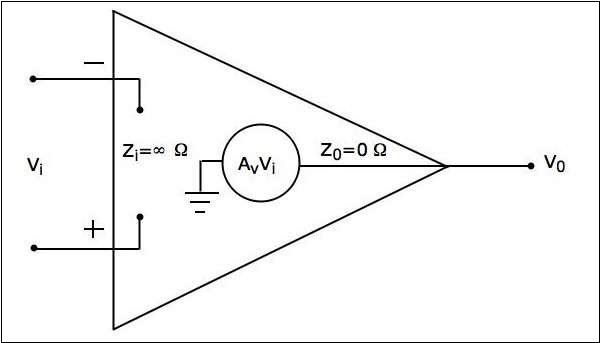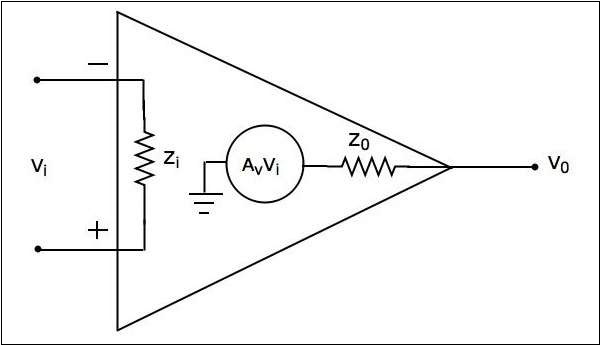
- Linear Integrated Circuits Applications
- Home
- Basics of Integrated Circuits Applications
- Basics Operational Amplifier
- Op-Amp applications
- Arithmetic Circuits
- Differentiator & Integrator
- Converters Of Electrical Quantities
- Comparators
- Log & Anti-Log Amplifiers
- Rectifiers
- Clippers
- Clampers
- Active Filters
- Sinusoidal Oscillators
- Waveform Generators
- 555 Timer
- Phase Locked Loop Ic
- Voltage Regulators
- Data Converters
- Digital to Analog Converters
- DAC Example Problem
- Direct Type ADCs
- Indirect Type ADC
- Useful Resources
- Quick Guide
- Useful Resources
- Discussion
Basics Of Operational Amplifier
Operational Amplifier, also called as an Op-Amp, is an integrated circuit, which can be used to perform various linear, non-linear, and mathematical operations. An op-amp is a direct coupled high gain amplifier. You can operate op-amp both with AC and DC signals. This chapter discusses the characteristics and types of op-amps.
Construction of Operational Amplifier
An op-amp consists of differential amplifier(s), a level translator and an output stage. A differential amplifier is present at the input stage of an op-amp and hence an op-amp consists of two input terminals. One of those terminals is called as the inverting terminal and the other one is called as the non-inverting terminal. The terminals are named based on the phase relationship between their respective inputs and outputs.
Characteristics of Operational Amplifier
The important characteristics or parameters of an operational amplifier are as follows −
- Open loop voltage gain
- Output offset voltage
- Common Mode Rejection Ratio
- Slew Rate
This section discusses these characteristics in detail as given below −
Open loop voltage gain
The open loop voltage gain of an op-amp is its differential gain without any feedback path.
Mathematically, the open loop voltage gain of an op-amp is represented as −
$$A_{v}= \frac{v_0}{v_1-v_2}$$
Output offset voltage
The voltage present at the output of an op-amp when its differential input voltage is zero is called as output offset voltage.
Common Mode Rejection Ratio
Common Mode Rejection Ratio (CMRR) of an op-amp is defined as the ratio of the closed loop differential gain, $A_{d}$ and the common mode gain, $A_{c}$.
Mathematically, CMRR can be represented as −
$$CMRR=\frac{A_{d}}{A_{c}}$$
Note that the common mode gain, $A_{c}$ of an op-amp is the ratio of the common mode output voltage and the common mode input voltage.
Slew Rate
Slew rate of an op-amp is defined as the maximum rate of change of the output voltage due to a step input voltage.
Mathematically, slew rate (SR) can be represented as −
$$SR=Maximum\:of\:\frac{\text{d}V_{0}}{\text{d}t}$$
Where, $V_{0}$ is the output voltage. In general, slew rate is measured in either $V/\mu\:Sec$ or $V/m\:Sec$.
Types of Operational Amplifiers
An op-amp is represented with a triangle symbol having two inputs and one output.
Op-amps are of two types: Ideal Op-Amp and Practical Op-Amp.
They are discussed in detail as given below −
Ideal Op-Amp
An ideal op-amp exists only in theory, and does not exist practically. The equivalent circuit of an ideal op-amp is shown in the figure given below −

An ideal op-amp exhibits the following characteristics −
Input impedance $Z_{i}=\infty\Omega$
Output impedance $Z_{0}=0\Omega$
Open loop voltage gaine $A_{v}=\infty$
If (the differential) input voltage $V_{i}=0V$, then the output voltage will be $V_{0}=0V$
Bandwidth is infinity. It means, an ideal op-amp will amplify the signals of any frequency without any attenuation.
Common Mode Rejection Ratio (CMRR) is infinity.
Slew Rate (SR) is infinity. It means, the ideal op-amp will produce a change in the output instantly in response to an input step voltage.
Practical Op-Amp
Practically, op-amps are not ideal and deviate from their ideal characteristics because of some imperfections during manufacturing. The equivalent circuit of a practical op-amp is shown in the following figure −

A practical op-amp exhibits the following characteristics −
Input impedance, $Z_{i}$ in the order of Mega ohms.
Output impedance, $Z_{0}$ in the order of few ohms..
Open loop voltage gain, $A_{v}$ will be high.
When you choose a practical op-amp, you should check whether it satisfies the following conditions −
Input impedance, $Z_{i}$ should be as high as possible.
Output impedance, $Z_{0}$ should be as low as possible.
Open loop voltage gain, $A_{v}$ should be as high as possible.
Output offset voltage should be as low as possible.
The operating Bandwidth should be as high as possible.
CMRR should be as high as possible.
Slew rate should be as high as possible.
Note − IC 741 op-amp is the most popular and practical op-amp.